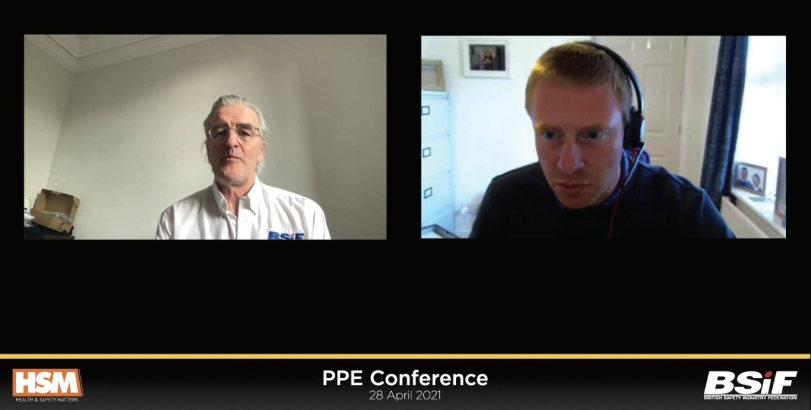
11 minute read
Save lives with correctly fitted RPE
Save lives with
correctly fitted RPE
Nick Baxter, PPE and RPE specialist at HSE’s Science and Research Centre, and Alan Murry, CEO of BSIF, speaking at the HSM/BSIF PPE Digital Conference, discussed the importance of fit testing to ensure employees are protected against workplace hazards.
lan Murry, CEO of BSIF.
Ian Murry and Nick Baxter at the HSM/BSIF PPE Digital Conference 2021. Each year thousands of people are killed or suffer illness from airborne exposures at work, much of which could be avoided if appropriate and properly fitted RPE was worn.
To explain the importance of correctly fitted RPE, Nick Baxter and Alan Murry gave a presentation at the HSM/BSIF PPE Digital Conference 2021.
Opening the session, Murry commented, “Elimination of a hazard is the first consideration in a hierarchy of control, followed by substitution and isolation. But in many circumstances, use of the correct fit-for-purpose RPE supported by the appropriate training of the wearer is the most appropriate method of control.”
In HSE’s RR1029 report, 25 volunteers wearing nine different RPE models underwent four different fit tests in random order. The results made clear that a significant proportion of the masks tested did not fit the range of users, leaving them exposed to potential hazards.
Murry said, “The HSE test demonstrated the importance of fit testing to establish a suitable mask for the individual wearer. Not all masks will fit all head shapes, and so it is vital that fit testing is carried out by a competent person. The RPE needs to be adequate for the hazard identified and needs to be suitable for the individual wearing it as well as the tasks they are carrying out.”
Baxted commented, “Unfortunately, often when people wear masks they do not wear them properly with three main things done incorrectly: the nose clip is not fitted, the straps are positioned incorrectly (ideally they want to be over the crown of the head and back of the head), and finally masks are often worn with facial hair.”
Baxter proceeded to outline the
main fit testing methods used in the UK:
Qualitative:
A simple taste test whereupon the wearer will equip the mask and then either a bitter or sweet tasting aerosol is administered while the subject carries out a number of exercises. If the wearer cannot taste either, then the mask fit is deemed to have passed. However, if they can distinguish the taste then the mask does not fit properly and fails. This is suitable for testing half masks, filtering face pieces but it is not suitable for full face masks.
Quantitative:
Split into Ambient Particle Counting and Control Negative Pressure test. -Ambient Particle Counting: Uses a machine that measures the concentration of particles inside and outside the mask while exercises are carried out by the subject. The ratio between the concentration of particles inside and outside is calculated which generates the fit factor to determine if it has passed or failed. This method can be used for filtering face pieces, half masks and full face masks. -Control Negative Pressure: Using the same exercises but after the wearer will hold their breath for the machine to generate a negative pressure inside the mask to determine how much leakage has occurred around the mask. This generates the fit factor to assess whether the mask has passed or failed. This method is not limited by any environmental conditions and is suitable for testing half masks, full face masks but not face pieces. ❖
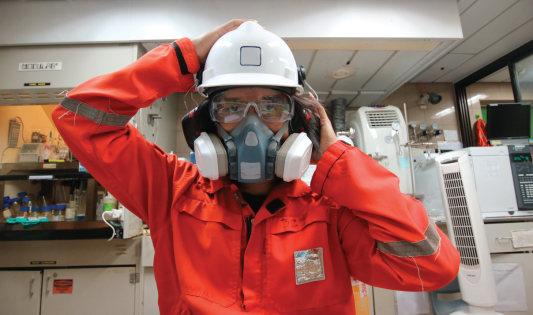
Masks must be properly fitted to prevent harmful airborne exposures.
Image Credit: Adobe Stock
To view the conference on demand follow this link: https://tinyurl.com/2d8m2zzk
Using particle-filtering face masks
Respiratory protection Particle-filtering face masks offer effective protection against aerosols and fine particles which can pose a hazard in the workplace, such as dust, mist, smoke and fumes.
EN 149, the European standard of testing and marking requirements for filtering face pieces defines three classes of such particlefiltering half masks, called FFP1, FFP2 and FFP3, according to their protection level. The protection level indicates how high the concentration of harmful substances (contaminants) can be without posing a health risk to the user. The higher the contaminant concentration, the higher the FFP protection class needs to be. Draeger explains the three categories:
FFP1: When the contaminant concentration reaches four times the occupational exposure limit (OEL), FFP1 masks must be worn. FFP1 masks can filter up to 80% of all contaminants that are fundamentally non-toxic and are water or oil-based. These masks protect against nontoxic dust particles, for example, such as those from pulp, cement, plaster, chalk or pollen. They offer reliable protection for cleaning (dust), agriculture (hay, grain, flour and much more); sanding, planing, cutting and drilling into concrete, masonry, iron, rust.
FFP2: FFP2 masks can be used in environments where the contaminant concentration reaches up to 10 times the occupational exposure limit. They filter up to 94% of toxic water and oil-based contaminants. Masks with this rating also offer protection against toxic dust particles, such as those from calcium oxide, concrete, granite or zinc oxide fumes. They offer reliable protection for sanding, cutting and drilling into cement, wood, steel, paint, lacquers, rust and plastic; welding construction steel and zinc; handling mould and bacteria in risk group 2.
FFP3: With FFP3 masks, the contaminant concentration must not exceed 30 times the occupational exposure limit. FFP3 masks filter up to 99% of all water and oil-based contaminants, which are harmful to health, carcinogenic or radioactive. They protect against toxic dust, for example, from chrome, cobalt, nickel or mould spores. They offer reliable protection for sanding, cutting and drilling into high-alloy steel; welding stainless steel or thorium electrodes; working with asbestos, diesel exhaust particulates/fumes; handling viruses and bacteria in risk group 3.
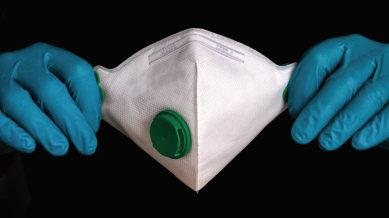
Particle-filtering face masks offer protection against aerosols and fine particles which can pose a hazard in the workplace.
https://www.draeger.com/en_sea/Safety/Respira tory-Protective-Equipment/FFP-Masks
Fighting Covid-19 misinformation
Matthew Frese, general manager of Med Learning Group, says that eradicating misinformation is essential in the global fight against the coronavirus pandemic.
ABOVE: Medical specialists, clinicians, patients and caregivers need access to reliable information. After more than a year of the Covid-19 pandemic, the global death toll attributed to the coronavirus has now topped 3.3 million people, according to a mid-May situation report released by the World Health Organisation (WHO).
In the UAE, where the death toll has reached 1,631 as of 16 May, the country’s government has successfully vaccinated more than 70% of its eligible population and conducted more than 54 million RT-PCR tests, as per the latest news sources.
As the nation begins to look beyond the pandemic, the UAE’s Minister of Health, His Excellency AbdulRahman Al Owais, recently reaffirmed the UAE’s commitment towards employing innovative treatments and strengthening international health partnerships. With its own house increasingly in order, the UAE – a vital logistics and supply chain corridor in global Covid-19 vaccine transportation – has also recently begun the first phase of a vaccination programme for refugees and displaced people in Iraq and Jordan.
While the UAE continues to set global benchmarks in managing the pandemic, the challenges of this moment are not few, nor are they easy to solve. One challenge is that information is scattered and often without the necessary verification to be considered reliable. Looking at this challenge in a global scenario, it is hugely important for patient and caregiver communities to be able

to access crucial information from a reliable resource platform.
Resource platform
As the adage goes, knowledge is power, and not all countries have been as effective as the UAE in controlling domestic misinformation and fake news surrounding the pandemic. This is why the Continuing Medical Education industry has created FRONTLINE (www.covidfrontline.com) – a resource platform designed to keep doctors and the community informed about the latest updates, guidelines, trends and resources related to the coronavirus.
FRONTLINE has tools to support medical specialists, clinicians, patients and caregivers in the search for the right sources of information to keep up to date with the growing data of Covid19. The platform contains predictors of disease severity, pathophysiology, symptoms, treatments, vaccines, as well as information on how Covid-19 affects health professionals and their capacity to care for existing patients. The free to access platform also enlightens readers on the latest approved treatments, such as monoclonal antibody therapy, which recently had emergency use approved in Brazil.
Since its launch, the site has become a trusted resource for education and updates on the coronavirus, with over 1.25 million views. According to our statistics, the professionals who took part in FRONTLINE education have demonstrated a 27% gain in knowledge and a 25% gain in competence.
All of this was only possible thanks to the joint effort made with institutions, such as the USA’s National Infusion Center Association, Infograph-Ed and Fundação Heroes of Lorna Breen, India’s Public Health Foundation, as well as AbbVie, Astellas, Genentech, Merck & Co. Inc., Lilly, Pfizer and Regeneron Pharmaceuticals, who came together to promote health and enable initiatives to fight the coronavirus.
In the fight against Covid-19, harnessing the power of international public-private partnerships – the type of initiatives being explored by the UAE – is key to our global family moving on from the pandemic. ❖
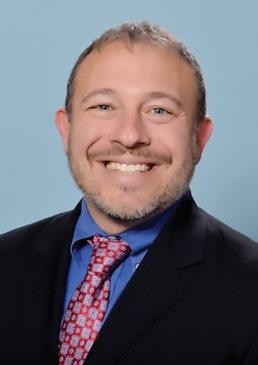
Matthew Frese, general manager, Med Learning Group.
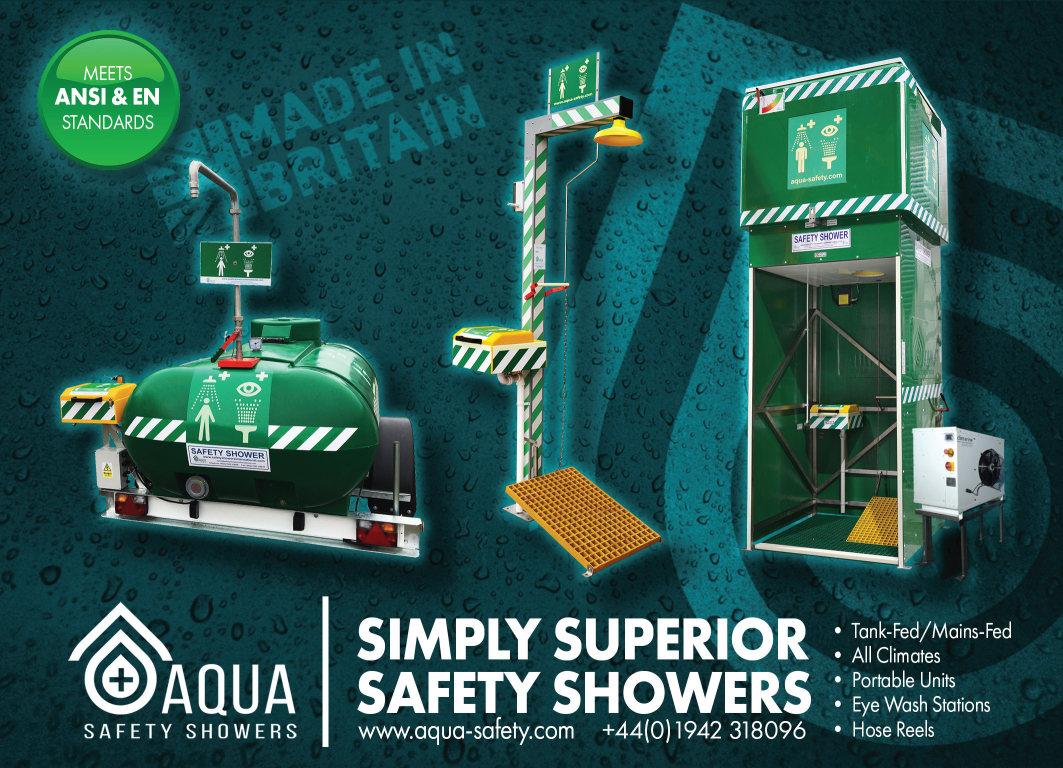
The importance of valuing human capital
Louise Hosking, director, Hosking Associates and IOSH-approved training provider, discusses the critical role human capital plays in the sustainable workplace, and the need for a balance between the values of ‘People, Planet, Profit’.
The United Nations’ (UN) published definition of sustainability is “Meeting the needs of the present without compromising the ability of future generations to meet their own needs”. To understand “human capital” we first need to consider this definition. In its simplest terms this is about “People, Planet, Profit”. There must be balance in all three for business to thrive and be truly sustainable. While we like to believe Health and Safety is our top priority, the reality is, it must be a priority value in harmony with these other aspects.
The UN Sustainable Development Goals provide the architecture for resolving many of these challenges. To achieve these goals, organisations need to transform current patterns of production, operation and consumption.
The Five Capitals Model (Natural Capital, Human Capital, Social Capital, Manufactured Capital and Financial Capital) expands the concept of “People, Planet, Profit”. These “capitals” interconnect and create a sustainable ecosystem. When we restrict one it affects another (see www.forumforthefuture.org/thefive-capitals).
Sustainable organisations place true value on good work, people and communities, charging a fair rate for a fair job and considering the impact on the planet.
Human capital includes things such as education, training, skills, health, and personal or shared values such as loyalty and punctuality. Think of the person within a business with the drive, knowledge, passion and the energy to make incredible things happen – now see them as an asset (a value) to the business. However, Health and Safety performance is not being consistently captured in most financial or public reporting on human capital, so it is not being given the importance it deserves.
Large organisations have significant supply chains which span the globe. Some are able to push hazards out from the centre into territories with little or no Health and Safety state regulation. Organisations may be tempted to exploit workers in the rush for greater profits.
Health and Safety professionals have a role to play in creating meaningful evidence-based reports which boards and stakeholders understand. With better reporting comes greater accountability, and customers will make informed choices which reward sustainable businesses and improve standards. Health and Safety becomes a value.
Evidence suggests investments in human capital, including higher education, yield long-term economic rates of return that exceed most standard investments in technology or capital. The more skilled and empowered the workforce, the more productive it tends to be.
Businesses need safe, healthy and engaged workers to thrive –something the investment community is looking at more closely than ever before.
Companies with a focus on sustainability will be in a better position to weather adversity, because they invest in prevention measures. We are currently experiencing adverse conditions, so there is an even greater focus on this, and we have seen ESG funds performing well. The desire for ethical investment will drive ethical values, which creates interest to understand more about the issues we Health and Safety professionals care about.
Good governance creates sustainable businesses attuned and in harmony with people, the planet and profits. ❖









